Reykjavík is the biggest city in Iceland and the world’s northernmost capital. Nearly two-thirds of the country’s population lives in this area. Granted, that’s only about 142,000 people—but what it lacks in size, it delivers in character, creativity, and energy. From cozy cafés and geothermal pools to bold architecture and a thriving music scene, the city punches well above its weight—and travelers are noticing. In 2025, Reykjavík ranked 25th in Europe in Tripadvisor’s Travelers’ Choice Awards: Best of the Best Destinations.
Reykjavík has a vibrant cultural and design scene, with plenty of exciting adventure tours, vivid nightlife, modern museums, world-class restaurants, galleries, shops, bars, and clubs to explore throughout your stay.
Iceland’s capital city is also a great base from which to experience some of the island’s breathtakingly beautiful natural wonders, such as the famous Blue Lagoon geothermal spa, the show of Northern Lights, or the amazing Golden Circle route.
You’ll witness spouting geysers in the nearby geothermal fields, cascading golden waterfalls, rift valleys, unique terrain, national heritage sites, and much more. However you choose to spend your time in Reykjavík and the surrounding area, this is a city break that is truly unique.
Learn everything important and useful for planning your stay in Reykjavík. After a brief history lesson, we’ll set you up with tips of must-see places and must-do activities, including all of the things you can do for free. We’ve also listed a bunch of helpful recommendations on where to eat and drink in the capital area.
Reykjavík was the location of the first permanent settlement in Iceland. It was established in 874 AD by a Norseman named Ingólfr Arnarson with his family and slaves. There was no urban development in the area during the following centuries. In 1225, an Augustinian monastery was founded on the offshore island of Viðey, which was later destroyed during the 16th-century Reformation period.
In the late Middle Ages and the early modern period, the country went through a civil war and was first absorbed into the Kingdom of Norway before later being absorbed into the Scandinavian Kalmar Union. After the union dissolved, Iceland came under the rule of the Danish Crown.
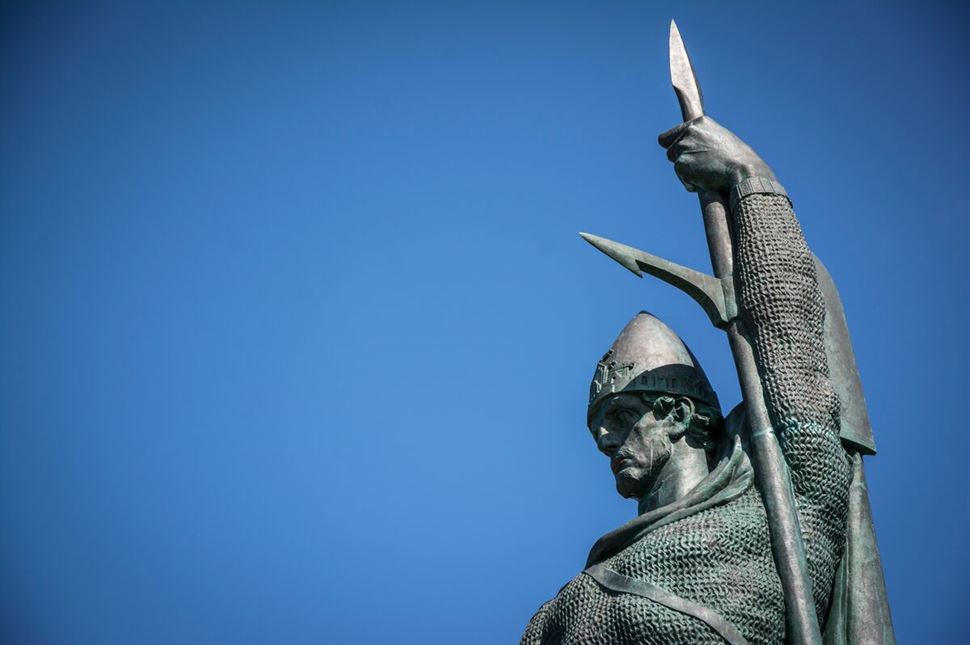
Statue of Ingolfur Arnarson, Icelandic explorer and one of Reykjavík founders.
In the early 17th century, the Danish king declared a trade monopoly on Iceland, leaving the country starving. Around this time, in the 1750s, local sheriff Skúli Magnússon, the “Father of Reykjavík”, established wool workshops in the area allowing it to quickly become a hub of wool production. Thanks to these workshops, Reykjavík started to grow significantly as a port and slowly transformed into a regional – and later national – center of commerce, population, and governmental activities. This growth was further boosted when the Crown declared free trade for Iceland with all nationalities. This year, 1786, is regarded as the foundation of Reykjavík.
In 1874, the Icelandic Parliament gained limited legislative power and, in essence, became the institution that it is today. In 1904, home rule was given to Iceland and the office of Minister for Iceland was established in Reykjavík. The biggest step towards independence was taken on December 1, 1918, when the Kingdom of Iceland became a sovereign country under the Crown of Denmark.
During WWII, with the rest of the world at war, there was a huge demand for sources of fish among the fighting nations. This was a service that Iceland could provide. Because of its strategic location in the mid-Atlantic, Britain invaded Iceland in 1940, helping to protect its fisheries, and then the US took over this protective occupation in 1941. When the war ended in 1944, Iceland declared its complete independence from Denmark. From that point on, Reykjavík became the capital city of this newly independent country.
After WWII, during the Cold War, some US troops remained in Iceland. During their stay, the Americans dramatically pushed Reykjavík towards development. They wanted to eat, drink, go out, attend cultural events, and be entertained. They also had a large social impact on the locals who started to feel the need to extend their social lives as well. To fulfill these new needs, Reykjavík started to develop new infrastructure. Bars and restaurants opened and the city began to invest in sports and the arts.
A once-simple village rapidly transformed into a modern city. During the last decade of the 20th century, cultural interest in Iceland grew rapidly due to pop bands and musicians such as Björk, Ólafur Arnalds, Múm, Sigur Rós, and Of Monsters and Men; the poet Sjón; and the visual artist Ragnar Kjartansson. Reykjavík was chosen as one of the European Cities of Culture and one of the UNESCO Cities of Literature. Today, it is at its peak as more and more visitors come to visit the northernmost capital. In 2024, approximately 2.3 million tourists visited Reykjavík.
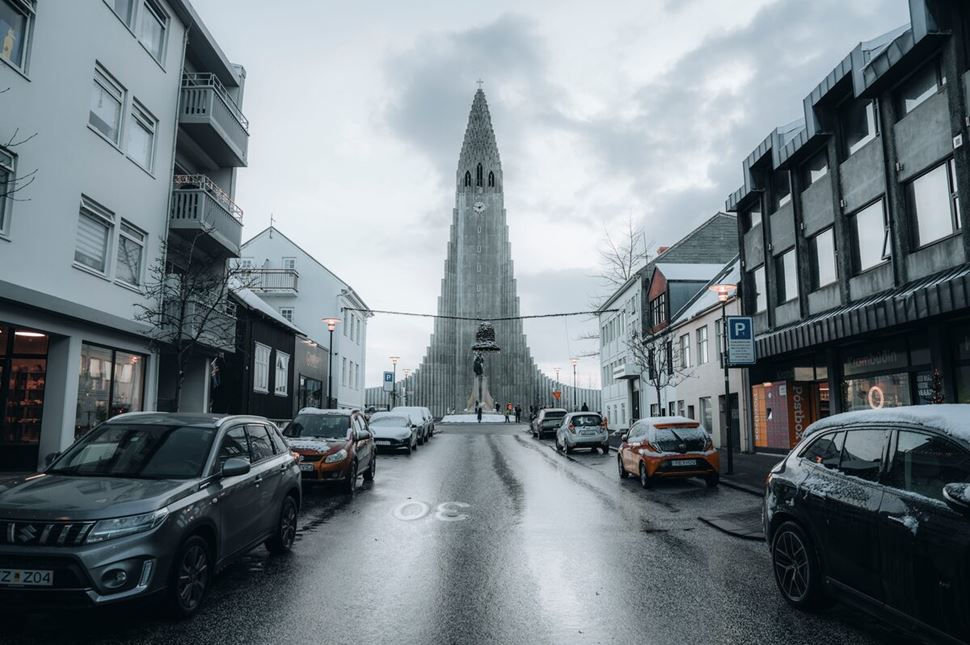
Hallgrímskirkja church in the center of Reykjavík. Photo taken by Gunnar Gaukur.
Getting to Reykjavík has never been easier. A number of airlines operate regular flights to Iceland, which depart from nearly 90 cities around the world. The majority of travelers arrive by plane and land at Keflavík International Airport (KEF). It is located 50 km (31 mi) from Reykjavík’s city center.
There is also a domestic airport in central Reykjavík and several small airports around the country, such as those in Ísafjörður (North-West), Egilsstaðir (East), and Akureyri (North). These airports receive a few international flights as well, mainly from Nordic countries.
Getting to Iceland by sea is also possible as numerous cruise ships sail to Iceland. Most of the cruise ships sailing to Reykjavík are from Europe or North America. There is also a scheduled ferry service on the Smyril Line. It departs from Denmark and crosses the North Atlantic with a stop in the Faroe Islands. This ferry does not, however, dock in Reykjavík but rather at a 10-hour drive from the capital in East Iceland.
Despite being quite small for a capital city, Reykjavík actually has two airports; Reykjavík Domestic Airport and Keflavík International Airport (KEF), with the latter, obviously being the destination most global travelers will encounter first.
Over 1.5 million visitors here every year, which is about five times the nation’s population. Famous visitors to arrive recently include Beyoncé and Jay-Z. A three-time winner of the Best Airport in Europe Award (ACI), Keflavík Airport is modern, compact, and easy to navigate.
Flying to Keflavík takes less than six hours from New York City or under 2 hours from London, but as soon as you touch the ground, it’s apparent that you’ve arrived in a very different world. Iceland’s roads are almost always clear, with breathtaking views stretching in every direction.
The short answer is: anytime! Every season has its own benefits. The best time for you to visit only depends on your own personal interests.
If you would like to see the Northern Lights, you should come between September and March. If the Aurora is the only reason for your visit, come between November and February when the nights are the darkest and longest.
If you would like to hike and camp, take long road trips, enjoy the benefits of the midnight sun, and see Reykjavík at its busiest, summer is the best option. Spring and autumn are the transitional seasons and the best for budget travelers and for those who want to get a little bit of every kind of weather and experience.
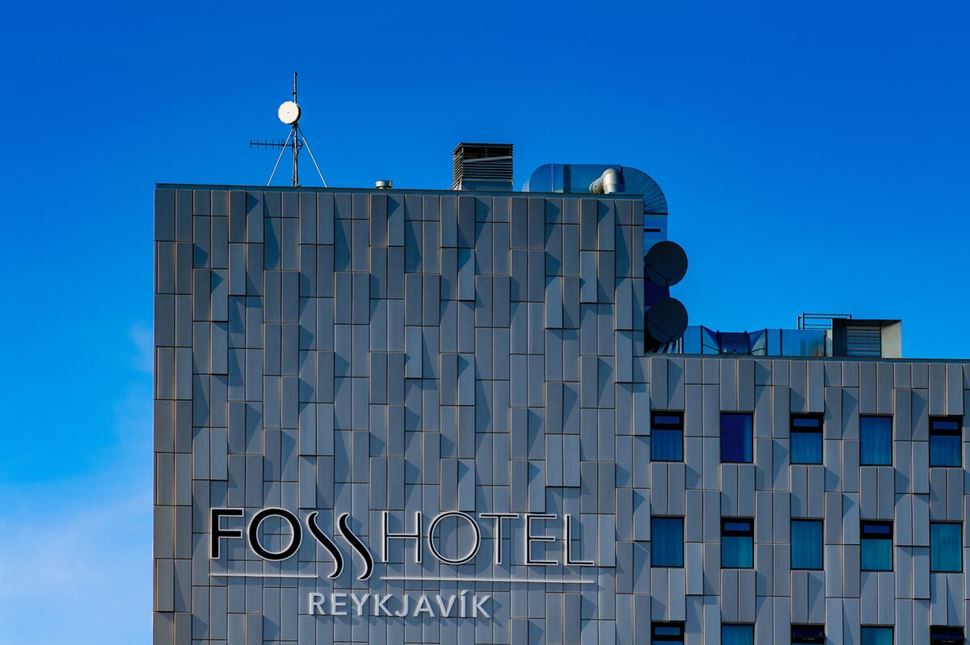
Foss Hotel is one of many accommodation options in the capital city.
Reykjavík offers a broad and varied range of accommodations to suit every budget and preference. However, during the summer months, it is more expensive, so a bit of planning and online digging may be required to find your perfect place. Below are some cheaper alternatives to Reykjavík hotels.
Airbnb: a very popular choice of accommodation among people visiting Iceland as they are available pretty much everywhere and offer great value for money. Just make sure to book well in advance to avoid disappointment, as a lot of Airbnb leasers have very long waiting lists, especially during peak tourism months. Some other options include:
Couchsurfing: If you are okay with sleeping on a random person’s couch, then go for it! While the idea of couch surfing may not be for everyone, this is the ultimate cheap option for those no-nonsense travelers who need to make do on a limited budget.
House Swap: House Swap is fast becoming a very popular means of offering affordable accommodation amongst Icelandic people and there are several Icelandic House Swap communities out there who are more than happy to help facilitate you in terms of this option.
Reykjavik’s Best Hotels: For something that little bit more luxurious, we recommend trying out the Alda Hotel. It is stylish and contemporary with a Nordic-inspired design which will leave you with a dilemma: whether to lounge in your spacious room, have a tasty beverage or beer in their beautifully designed bar/lounge area, or go forth and explore everything that the city of Reykjavik has to offer.
The hotel is conveniently located close to the city’s main shopping and nightlife street, Laugavegur, with many rooms having views over Faxaflói Bay or toward Mount Esja (be sure to specify in your booking that you want one of these views, as such rooms are in high demand and limited supply!). There’s even a barber’s shop in the lobby if you feel like sprucing up so you can look your best before hitting the city streets.
Centerhotel Arnarhvoll is another popular choice with visitors, and for a good reason. It’s gray, and the austere exterior may not seem all that welcoming at first, but once inside the Arnarhvoll, you’re in for a real treat.
The hotel’s top floor has a Sky Lounge and a Sky Bar (which is open to all, meaning you can pay it a visit even if you are not staying at this particular hotel), and its views of the adjacent Harpa Concert Hall, Faxaflói Bay, and the nearby mountain range are sublime.
Pro tip: Some hotels that offer better rates are located quite far from the city center, so unless you’re willing to undertake a 30-minute plus walk or willing to pay for a cab to take you downtown every day, make sure to check your intended hotel’s location on Google Maps or similar, before booking.
If you’re going to Iceland, you can’t leave without dedicating a day to exploring Reykjavík. Ranked 25th on TripAdvisor’s Best of the Best Destinations list, the city has everything for everyone, including a bustling nightlife and architectural beauties that take your breath away. Night or day, there is always something to see and do at every hour you stay here!
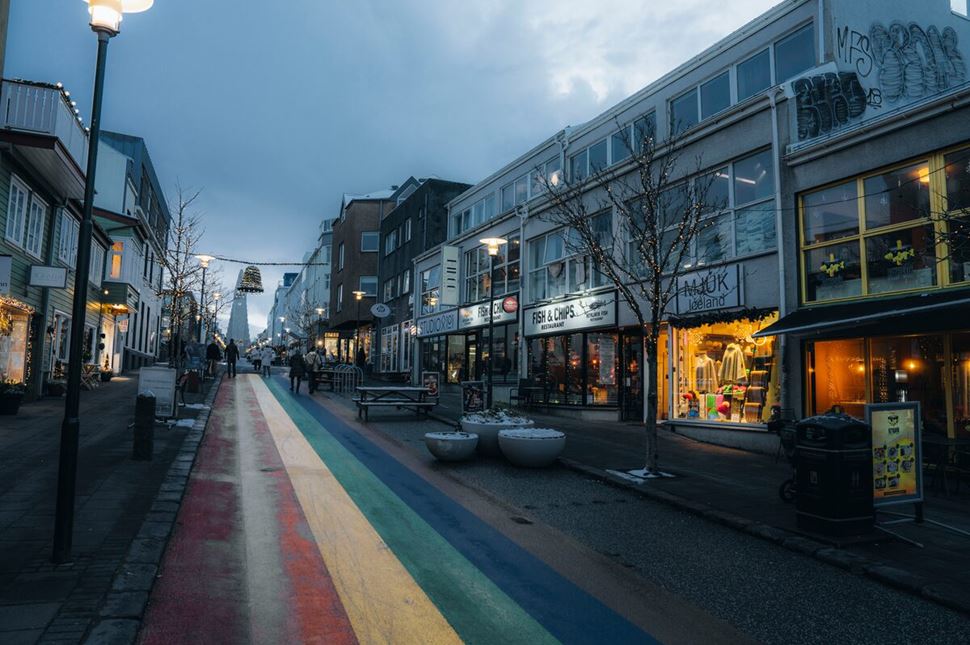
Day or night—there is always something to do in the streets of Reykjavík. Source: Gunnar Gaukur.
Reykjavík has a lot to offer during the day. Below we’ve outlined some of the more popular things to do and we always encourage people to go out and find their own Icelandic adventure.
Reykjavík’s town center is relatively small, which makes it easy to explore on foot in 2-3 hours. Laugavegur and Skólavörðustígur are the city’s main shopping areas, with the latter being ultra-trendy and increasingly popular.
This area is decorated with very cool and alternative street art and leads up to Hallgrimskirkja Church. The church itself is one of the most iconic and instantly recognizable buildings in Iceland and reminiscent of something you might see in The Lord of the Rings. Inside, modern art furbishes the foyer, iPads offer a wealth of additional information, and an elevator takes visitors to the top of the building, where they can enjoy awe-inspiring panoramic views of the city.
» A Metal Statue called the Sun Voyager resembles a Viking longboat on the Reykjavík seashore. This piece of artwork by Jón Gunnar Árnason is one of the most popular attractions in Reykjavík and makes a great photo location, offering a stunning view of Mount Esja on the opposite side of the bay.
» The Flea Market is open every weekend and offers an amazing variety of handmade artifacts, jewelry, and knitted wares among the many interesting antiquities and secondhand items.
» The Old Harbor area offers a stunning selection of fish and steak restaurants, cafés, and a lovely atmosphere that resembles the city’s close relationship with the sea. The whale-watching, fishing, puffin-watching, and Northern Lights boat tours depart from here.
» The Parliament Building hosts the meetings of the Icelandic parliament (Alþingi). It was built in 1880-1881 and has the oldest public garden in Iceland. The modest parliament building is also home to the National Library, the Antiquities Collection (a precursor of the National Museum), and the National Gallery.
» The City Hall and the Pond, called Tjörnin, and the nice park that surrounds them is another of the most commonly recommended places in Reykjavík to explore. The prominent lake is home to 40-50 bird species, and the park is one of the locals’ favorite recreation areas.
» The Cabinet House was originally built to accommodate vagabonds in the 18th century, but then the Danish government decided that the house should serve as a prison, which it did until 1816. In 1904, when Iceland was granted home rule, this announcement was read publicly on the steps of the Cabinet House, and then the official flag of the country was hoisted for the first time in front of this building. Consequently, the house was occupied by the ministers of the Icelandic government and got its present role.

Statue by Einar Jónsson in front of the Cabinet House.
» Laugavegur is the main shopping street in Reykjavík. Most of its fame comes from the boutiques, souvenir stores, restaurants, and bars found here. This street is one of the oldest in the city and is considered to be the heart of the downtown area.
» Hallgrímskirkja church, with its height of 74.5 m (244 ft), is the largest church and one of its tallest structures in Iceland. It is visible from everywhere in the city as it sits at the top of a small hill. Hallgrímskirkja is a Lutheran parish church designed to resemble the rugged landscape of Iceland, with its trap rocks, mountains, and glaciers.
» Perlan, a distinctive glass dome resting on five water tanks on the top of a hill, now serves as a museum, café, and restaurant. It offers one of the best views over Reykjavík and is surrounded by a beautiful, small, forested park.

Perlan museum—beautiful from the outside and entertaining from the inside. Source: Arctic Adventures
» Harpa Concert Hall, for all the culture vultures out there, Reykjavík’s Harpa Concert Hall is a nailed-on must-see experience. The impressive contemporary structure cost €164 million to build over a four-year period. The glass and steelwork are nothing short of breathtaking, and the designs’ impressive detailing will keep those who are way inclined entertained for hours. The Harpa Concert Hall offers year-round cultural events as well as daily exhibitions during the summer months.
The award-winning architecture of Harpa hosts a diverse range of events, from classical concerts and local poetry readings to traditional Icelandic folk songs and hymns sung and performed by talented local singers and pianists. There are even regular stand-up comedy shows on offer, which give a great insight into the funny side of Icelandic culture and the nation’s unique sense of humor.
If you enjoy exploring the building's history and fully experiencing its award-winning architecture, the Harpa Centre offers tours that provide access to areas not typically open to the public. Your guide will share some of Harpa’s secrets, stories of odd incidents, and the struggles they faced during the economic crisis.
Reykjavík has an abundance of exciting things to do at night, which will cater to all different types of night owls, thrill-seekers, and cultural vultures. Below, we’ve listed some of our favorite parts of the city’s bustling nightlife:
For most visitors, the main activities in Reykjavík during the winter months are the Northern Lights tours. If the Aurora is strong enough, you will be able to see the lights from anywhere in the city. The best is, however, to seek a place where light pollution is at its lowest and where there are no large buildings around to block the view of the horizon.
The best place for Aurora hunters in Reykjavík is probably the Grótta Lighthouse. It is located quite far from the downtown area (a 1-hour walk), but the light pollution is minimal, and you have almost a 360-degree view. Other good options include the coastal walking area next to the Harpa Concert Hall, any larger city park, or the Perlan.
This excellent 3-5 hour Northern Lights trip by Super Jeep takes in the wonder of the lights. The Northern Lights, also known as the Aurora Borealis, is one of nature’s most mesmeric sights, and it will leave you utterly awestruck. The name Aurora Borealis is derived from Latin and translates to “the dawn of the north.” Aurora was a Roman goddess of dawn, and Boreas is the Greek God of the north wind. During the 13th century, Norwegians used the name “Northern Lights” for the first time.
The best times of the year to witness this stunning natural light show are September through March when cloud cover tends to be more limited. While it is impossible to be 100% certain of good weather, between 9 PM and 2 PM is generally the best time to see the Northern Lights.
The tour starts with a VIP pick-up in one of our custom-built 4×4 super jeeps, which will whisk you away from the city and advance into the darkness of the Icelandic wilderness in style. The jeep gives us the flexibility to go off the beaten path to locations big tour buses cannot reach, meaning you can experience the Northern Lights in all their wonder without the discomfort of large crowds. There is nothing like some hot chocolate to keep warm in the cold, and brave ones can even add some Icelandic Brennivín to theirs!
People often ask us, what is the nightlife in Reykjavík like? Well, it’s pretty amazing, to be perfectly honest. Reykjavík has gained a reputation for its vibrant nightlife and is nearly universally praised by tourists and travel journalists alike.
Thanks to its size, the downtown area is ideal for bar crawls. The best local bars and breweries can be found everywhere, and the craft beer selection is stunning.
The nightlife in Reykjavík centers around the main shopping street, Laugavegur. There is plenty of life in neighboring Hverfisgata and Laugavegur as well. Adjacent to Austurstræti is Hafnarstræti, with a few bars also located on Naustin Street. Walking from bar to bar, you’re not going to break into much of a sweat as they are less than 20 paces from one another, which means the streets are as lively and entertaining as the bars themselves, weather permitting, of course.
Bar hopping is the norm here, and it’s rare for locals to stay in one place for the full night. All of this makes for a hugely entertaining evening of delicious bite-size samples of varying vibes and multiple music genres. Very few of these bars charge entry fees (unless there is a live band playing or something very special going on), meaning you can hop from one bar to another, changing your location if you don’t like the music or surroundings (or if you’re looking for love!).
Cocktail bars and dance clubs are numerous, and one can find a good place to enjoy any party style in the downtown area for sure. To the joy of bar crawlers, some hot dog stands are open around the clock downtown.

Harpa Concert Hall hosts comedy shows and concert performances. Image by Arctic Adventures.
Another hugely popular Icelandic pastime is hot dogs! The humble hot dog is so beloved in Iceland that it is now regarded as the unofficial national food of choice. And nowhere are they more celebrated than in Reykjavík, where the most renowned place to get one is at Bæjarins Beztu Pylsur (which directly translates to “best hot dogs in town”), which opened in 1937 and has fed famous visitors like Bill Clinton and the heavy metal band Metallica. The stand even has its own signature hot dog called “ein með öllu” hot dog (that’s “the one with everything”, where the lamb-based hot dog is covered in ketchup, mustard, fried and raw onion and remoulade, a type of sweet mayonnaise dressing), but unadventurously, Bill chose one with just mustard (AKA the American classic)!
Pro tip 1: Be prepared to wait. They are just that popular, day and night.
Pro tip 2: Have your money out and ready when at the top of the line. Each Hot Dog costs around 600 to 750 ISK (€4.14–5.17 / $4.70–5.88).
The city has something for every type of traveler, from organized sightseeing excursions and popular sight-walking tours to food and beer outings. Explore the most popular ones, which have the advantage of being guided by locals who know all the history, folk tales, fun facts, and secrets of the city. The many guided activities in Reykjavík, from hop-on hop-off buses to small group walks that allow you to get to know the city and its surroundings in the best way possible.
Discover more tours from Reykjavik, from multi-day adventures to single-day experiences tailored to your preferences for exploring Iceland to the full.
Get the Reykjavik City Card and enjoy discounts and free entry to museums. The card allows you to take advantage of the many galleries, museums, restaurants, cafes, swimming pools, and buses in the city. Choose from a 24, 48, or 72-hour card or a Children’s Card for your kid.
Reykjavík is famous for its vibrant street art scene. Urban graffiti and sophisticated wall poems appear on every third building in the downtown area, but there are probably hundreds of pieces scattered all over the city.
The Fish Market offers an array of beautifully crafted seafood dishes and expertly selected wines to choose from. The platter of king crab legs is highly recommended, as is their sushi selection. They also serve more meaty meals for non-seafood lovers, and a tasting menu is available for those who want to try it all. The restaurant also serves smoked Puffin breast, which we’re told was one of the Icelandic people’s dietary staples in centuries past.
For people on a tighter budget, Reykjavík has a great range of mid-price places to eat with great views, such as Reykjavík Röst—a coffee house/bar. Opened in 2017, this place is located right near the capital bay and provides a perfect POV for coming in and leaving ships. The menu features a mix of traditional Icelandic and contemporary dishes at reasonable prices. A smoked lamb dish will cost around 3,890 ISK (€26.81 / $30.49), while a cup of espresso is just 700 ISK (€4.82 / $5.49). You can also get various soups, sandwiches, and cocktails while enjoying the perfectly peaceful view of the harbor.
Of the many places to eat in Iceland, there are plenty of vegan and gluten-free options as well as cozy cafés, bakeries, confectioneries, and ice cream shops.
If you prefer to explore the city by yourself, you can easily walk around the downtown area in just a few hours. We created a Reykjavík city walk map for your self-guided walking tour, which includes all the must-see locations within walking distance of the downtown area.
Reykjavík is renowned for its consistently changing weather, regardless of the time of year. Below, we’ve listed some ways to help prepare for it, as well as some other helpful (and perhaps not so helpful) bits of information to make your trip a pleasant one.
Iceland has a rich musical history and is the place that has shaped artists such as Björk, Sigur Rós, and Of Monsters and Men. Björk was born and raised in Reykjavík, and the experiences she had here shaped her music. “I used to walk outside on the outskirts of Reykjavik—it was a 40-minute walk to school through winter in the dark and in blizzards sometimes. This is where I started writing my melodies,” she has said. “This is where I come from, what I’m made of.”
The Iceland Airwaves is one of Iceland’s premium music festivals, and you can experience it in early November.
Other festivals that take place in the Icelandic capital are the Winter Lights Festival, the International Festival of Children’s Literature, the Reykjavik International Film Festival, the Reykjavik Fashion Festival, Design March, and the Ingólfshátíð Viking Festival—where Vikings from around the globe gather to celebrate their heritage (don’t worry though – it’s totally safe – modern-day Vikings are friendly folk!). There truly is a festival to suit every taste in the city of Reykjavik.

Winter in Reykjavík casts a golden glow over the city’s pond and skyline. Captured by Gunnar Gaukur.
The weather in Iceland is fickle all year round, but especially during the winter months when travelers run the risk of having well-laid plans ruined by Mother Nature if weather forecasts are ignored. A couple of weeks before departing, you should check the road and weather conditions via official government websites. Packing your clothing for your trip should also be tailored around the forecast and conditions that await. As a renowned Icelandic scholar once told us, “There is no such thing as bad weather, only bad choice of clothing.”
In Reykjavik, the weather is generally milder and wetter than elsewhere in the country. Average temperatures are between -2°C and 2°C (28°F and 36°F) from December to March. They start to rise slightly in April and May to reach highs of 7°C to 10°C (44.6-50°F) in the summer months. Occasionally, it can be 13°C to 14°C (55.4-57.2°F) in summer. The temperatures start to decrease from September until November when winter returns with its freezing temperatures.
Most precipitation falls between October and March, which are also the windiest and darkest months. Read our comprehensive guide to the weather in Iceland to find out more.
During the winter season, you’ll need to plan your excursions carefully as daylight is at a premium during the colder months. Likewise, if you’re visiting during the summer, you can expect near-constant daylight. While this does allow for a lot more sightseeing, it can be exhausting if you don’t keep track of time. Although most hotels and guesthouses have light-blocking blinds or curtains, you should consider bringing an eye mask just in case, especially if you’re a light sleeper.
Iceland has consistently ranked near the top of the list of the safest countries in the world for decades, and Reykjavík has also topped the list of the safest cities. The crime rate here is unbelievably low! Scams, racism, homophobia, violence, and sexual harassment are almost nonexistent. If you are afraid of walking down the streets at night, you should come to Reykjavík in the summer as there is no darkness at all.
If you happen to spot a seemingly abandoned baby napping outside, don’t panic! For generations, Icelanders have believed in letting infants sleep in the fresh air—even in cold temperatures—and routinely leave their precious cargo in their strollers while they run errands.
Arctic Adventures has a wide range of adventure and sightseeing tours that cater to every budget and ability level, available year-round. Hiking, caving, diving, snorkeling, glacier hiking, whale watching, super jeep tours, volcano tours, snowmobiling, food and drink tasting tours, and much, much more await you. The only problem you will face is trying to figure out which tours you want to do in the time available to you!
All sorts of adventure and activity tours run from Reykjavik on a daily basis. We also offer meet-on-location tours for those who have a rental car. Whale watching in Northern Iceland, boat tours on the glacier lagoon, ice cave, and volcano exploration trips… all of these can be accessed from Reykjavík. Below are some of our favorite choices:
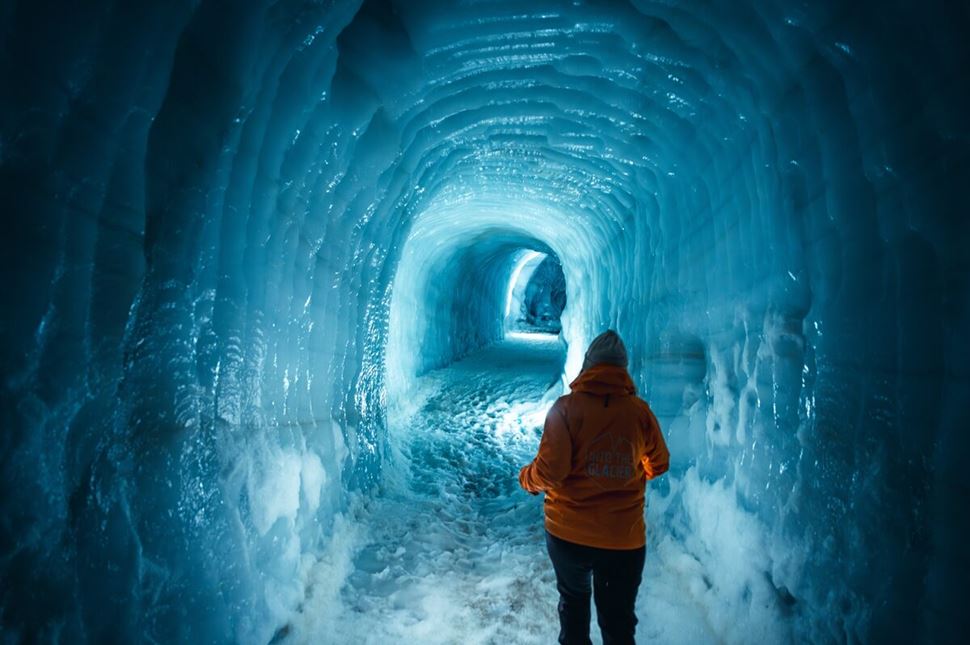
The blue shimmering ice walls of Into the Glacier ice cave. Source: Arctic Adventures.
Some incredible sights that you can quickly experience from Reykjavík include the stunning ice caves inside Langjökull Glacier (Europe’s 2nd largest one), Hraunfossar Waterfall, and Deildartunguhver—Europe’s most powerful hot spring. Travel to the caves includes a trip inside an 8-wheel monster truck!
Pick-ups commence from 8:30 to 9:00 AM, and warm clothing and footwear are a must, even during the summer months. Browse our selection of Ice Cave Tours for more information on what Arctic Adventures offers.
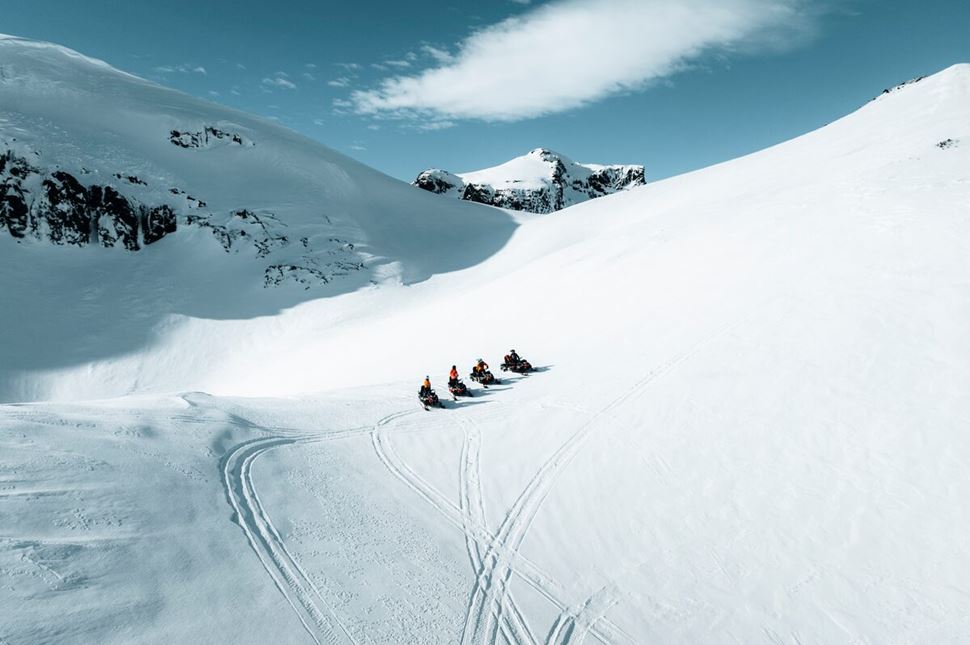
People snowmobiling across the white plains of a glacier in Iceland. Captured by Gunnar Gaukur.
An adrenaline-fuelled, high-powered snowmobile trip is a must for anyone with a thrill-seeking bone in their body. The day starts off with pick-up from your Reykjavík hotel or hostel location, and from there, it’s on to Langjökull Ice Cap for a white-knuckle ride across Europe’s second-largest glacier. Snowmobile tours can also be combined with other popular activities in close proximity to the Reykjavik area, such as the popular Golden Circle tours.
The snowmobile rides are perfect for both novices and more experienced riders alike. Instructions are available for first-timers, and all snowmobiling gear is provided. However, you are still advised to wear warm clothing, including a thermal shirt or fleece, warm pants (thermal if you have them), and boots instead of shoes/trainers, as wind chill can really pick up when riding a snowmobile.
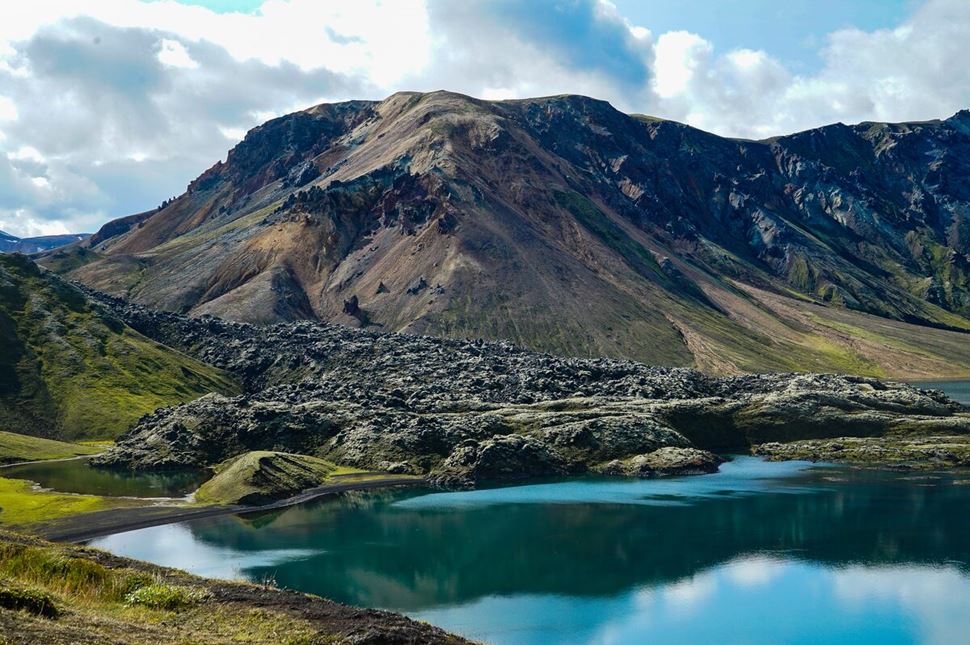
Landmannalaugar and its rhyolite mountains. Source: Arctic Adventures.
Any hiking or hill-walking enthusiast will enjoy hiking across Landmannalaugar Nature Reserve to witness the devastatingly beautiful untouched landscape that will live long in memory.
An 8–10 km (5–6 mi) hike usually takes around 4 hours to complete, so be sure to allocate yourself plenty of time to get through it. The typical Landmannalaugar route goes over Laugahraun Lava Field, through Vondugil Canyon, and up to Mt. Brennisteinsalda.
On the way back, you will descend down Graenagil Gorge, locally known as Green Gorge, due to the dominant and vibrant green color of rhyolite in the area. The final leg of the trip will see you reach the summit of Blahnukur Volcano before taking a dip in the hot spring pool of Landmannalaugar to soothe your body and soul. Just don’t forget your bathing suit and towel!
Reykjavík is built on top of several geothermal springs. This is where its name comes from: Reykjavík translates to “smoky bay.” Locals have made their lives more comfortable by soaking in the hot springs and when the city was modernized, they built geothermal swimming pools that use the naturally hot water that comes from the ground for free.
You can enjoy many of the natural hot springs tours throughout Iceland or the 18 swimming pools in the greater Reykjavík area. Here are the top five: